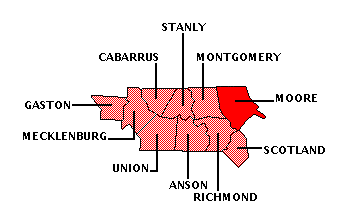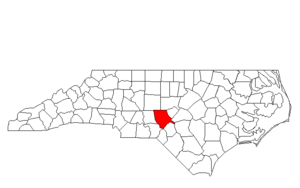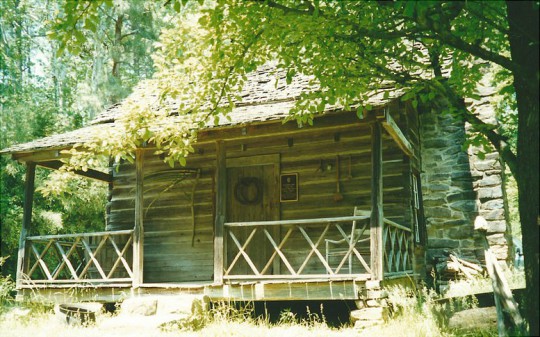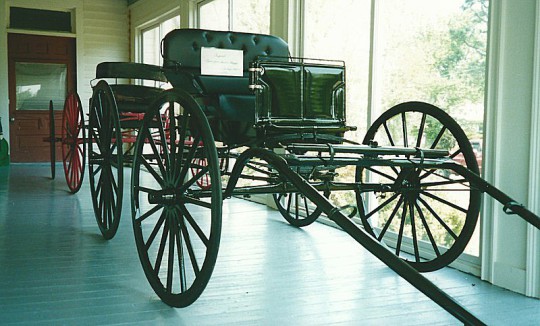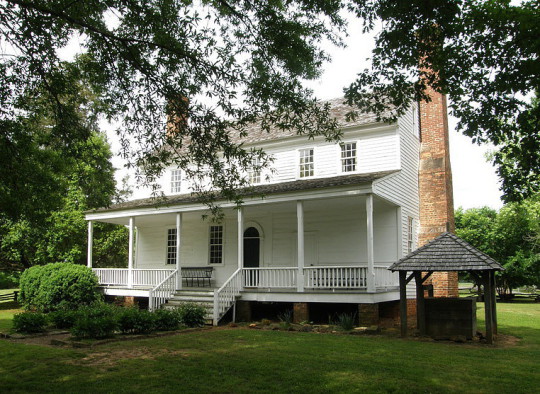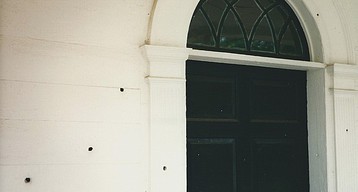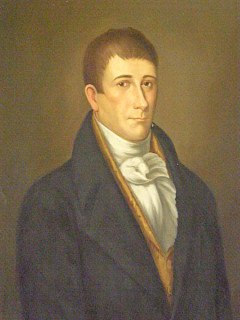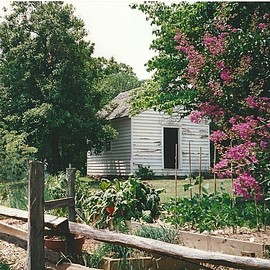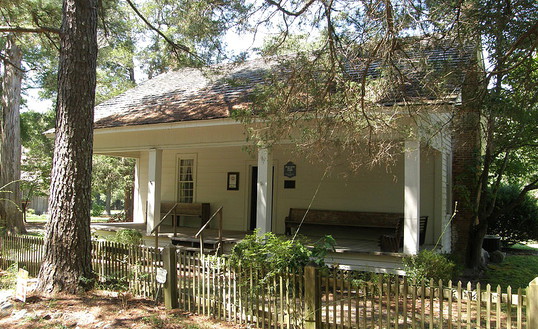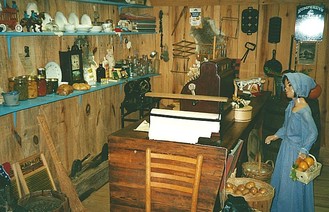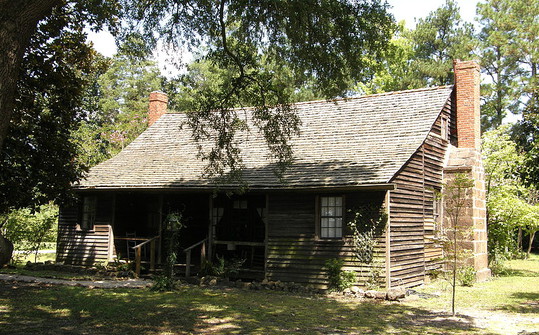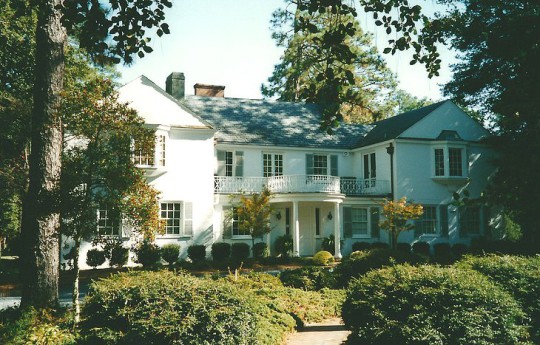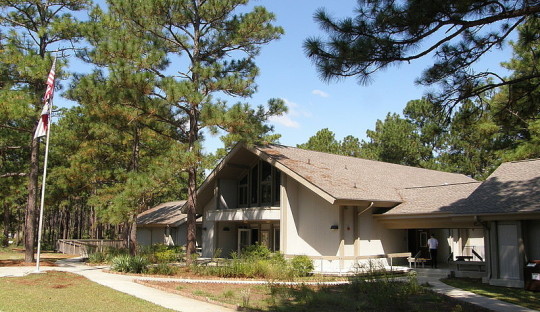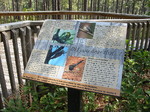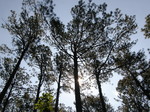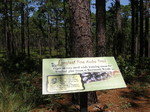MOORE COUNTY
Scroll down this page or click on specific site name to view features the following Moore County attractions/points of interest:
Bryant House & McLendon Cabin, Carthage History Museum, House in the Horseshoe State Historic Site, Malcolm Blue House, North Carolina Taxidermy Hall of Fame, Shaw House - Sanders Cabin - Garner House, Weymouth Center, Weymouth Woods-Sandhills Nature Preserve
Fast facts about Moore County:
Created in 1784, the county is named for Alfred Moore, a Revolutionary War officer and a US Supreme Court justice.
The county seat is Carthage, named after the ancient city in northern Africa. Other communities include Aberdeen, Cameron, Pinehurst, Robbins, Southern Pines, and Whispering Pines.
Moore County’s land area is 697.74 square miles; the population in the 2010 census was 88,247.
It is worth noting that the famous Pinehurst Golf Club is located in Moore County.
West of Carthage
The Bryant House and McLendon Cabin are two properties that recall antebellum country life. The former, built circa 1820, is a simple, unadorned two-story frame structure. Despite its modest appearance, it is considerably more imposing and spacious than the single room McLendon Cabin that stands next door. Built by Joel McLendon in 1760, the log house is the oldest surviving structure in Moore County. McLendon’s mill stood nearby, on a creek that still bears his name. The Bryant House and McLendon Cabin are located about six miles southwest of Carthage. To visit these buildings, head west on N. C. 24/27. Turn left onto State Road 1210 (Mount Carmel Road) and go about five miles. The buildings are on the left, just before crossing McLendon Creek. Admission is free. The Bryant House and McLendon Cabin are open for tours 2-4 on the 2nd and 4th Sundays from June through October. 910-692-2051
Carthage
In 1998, the Carthage History Museum moved from its original downtown location to a modest frame house built by Robert and Emma Burns circa 1894. Although much space is devoted to exhibits of mostly regional interest, one large room focuses almost exclusively on the town’s famous Tyson and Jones Buggy Company. For nearly three-quarters of a century, this Carthage-based business was the leading manufacturer of fine carriages in the entire southeast. Along with a reputation for excellent craftsmanship, Tyson and Jones also offered a wealth of choices, ranging from simple open buggies to fancy surreys to well-appointed landau carriages. A 1910s catalog on display in the museum pictures no less than eighty styles from which buyers could choose. During its peak production years in the 1890s, the company produced more than 3,000 vehicles per year. A finely restored buggy, circa 1925, the company’s last year of production, is on permanent display in a glassed-in side porch. Many more vehicles manufactured by Tyson and Jones are on view at the town’s annual Buggy Festival. Begun in 1989, the two-day event is held the Friday and Saturday before Mother’s Day and draws over 15,000 visitors to the Moore County seat. From the old courthouse building at the town square in Carthage, go three blocks east and turn right onto Rockingham Street. The museum is one block south, on the right. Admission is free. Hours are 2-5 Sundays, or by appointment. 910-947-2331
Northeast of Carthage
The descriptively-named House in the Horseshoe is pleasantly situated in a bend of the Deep River in the heart of the North Carolina piedmont, about ten miles north of Carthage, the county seat of Moore County. Also known as the Alston House, this state historic site was the scene of a Revolutionary War skirmish and, later, home to a North Carolina governor. The Philip Alston House, more commonly referred to as the House in the Horseshoe, gets its picturesque nickname from its location on a hillside overlooking a horseshoe bend of the Deep River. The two-story frame house, built by Alston circa 1772, was at the time of its construction one of the finest homes in this part of the state. Similar in style to those in the coastal lowlands, it features a gable roof, double-shouldered Flemish bond chimneys, and a shed porch.
The house gained historic import in July, 1781, during the closing months of the Revolutionary War, when it became the scene of a fierce skirmish between Tories under the command of Edmund Fanning and Whigs, who were led by Alston. Alston’s men were encamped at the house when they were attacked by Fanning’s larger force. After a lengthy exchange of gunfire, Fanning’s men attempted to drive the Whigs out of the house by setting fire to it, a strategy that ultimately forced Alston and his men to surrender. Almost 230 years have passed since the fighting took place, yet numerous bullet holes still scar the home’s exterior walls. Although Alston served in the state militia, held a position as justice of the peace, and was elected to the N. C. General Assembly, controversy surrounded his later life. He lost his seat in the state legislature, was removed as justice of the peace, and was twice indicted for murder. Alston sold the house and plantation in 1790 and left North Carolina.
In 1798, the property was purchased by Benjamin Williams, a prominent N. C. statesman who served as an officer during the War of Independence. The new owner named his plantation home “Retreat.” Williams held many political offices during his career, including three consecutive one-year terms as governor from 1799 to 1802 and a single one-year term from 1807 to 1808, as well as several terms in the state legislature. He was also a member of the first board of trustees for the University of North Carolina and held a seat in the Third U. S. Congress in Philadelphia. Beginning in 1801, Williams achieved his goal of becoming a planter. Within a matter of a few years, more than 100 slaves were working Williams’ 2,500-acre estate, raising cotton and grain. Williams also operated a racetrack and horse breeding facility. Williams died in the home in July, 1814, but he was not originally buried on the property. His body was re-interred on the site in 1970.
The house showcases both of its prominent owners. The current center-hall plan reflects changes Governor Williams made to the house in the early 19th century. In addition to guided tours of the four furnished rooms of the main house, the site also includes a reconstructed loom house, corncrib, well house, and garden. The visitor center occupies a former pack house. Along with the gravesites of the Governor and other family members, there is a monument erected by the Daughters of the American Revolution commemorating the July 29, 1781 skirmish. A battle reenactment is an annual event held the first weekend in August. The House in the Horseshoe is open 10-4 Tuesday-Saturday. Admission is free. 910-947-2051
Aberdeen
The Malcolm Blue Farm and Museum in Aberdeen exempli-fies a successful grassroots effort on the part of local citizens to safeguard an important link to the community’s past. Visitors today can see the restored 1825 farmhouse, several related dependencies, a working grist-mill, and a regional museum. The Malcolm Blue farmhouse stands as one of the few surviving examples of the 19th century homes of the Scottish immigrants who forged settlements in a wilderness area known at the time as the “Pine Barrens.” Malcolm’s father, John, came to North Carolina with his parents in 1767. They were among the first Scottish settlers to arrive in this challenging wilderness, where sandy soil and the thick canopy of virgin pine made for poor farming. Through perseverance, the Scottish community grew, and an early church was built near present day Aberdeen. After visiting the Blue Farm, consider stopping by the historic Bethesda Church on your way back to Aberdeen. The present sanctuary was erected in 1833, built from timber cut on Malcolm Blue’s property. Malcolm joined the church that same year, served the congregation as an elder for forty years, and, along with his wife Flora, is buried in the church cemetery. Malcolm’s home is about a mile from the church. Over time, Malcolm Blue became a wealthy individual thanks to the burgeoning turpentine and lumber industries and, at the outset of the Civil War, he owned more than 6,800 acres.
In addition to touring the restored farmhouse, visitors will enjoy the Martha C. Thomas Museum. Built in 1986, the structure resembles a 19th century barn and seems quite at home on the property. The building is literally filled to the rafters with exhibits pertaining to regional history. One display focuses on the region’s early industries – naval stores and lumber. Before and after the Civil War, turpentine – a.k.a. “sticky gold” – was the area’s economic mainstay. A 15-minute video provides an informative overview of how pine trees were “boxed” and sap harvested. Lumbering gained in importance in the 1870s, and in 1877, the first railroad came to the region. In 1892, Malcolm Blue’s nephew John founded the Aberdeen and Rockfish railroad line. An extensive exhibit on the Museum’s second floor details the battle of Monroe’s Crossroads, a cavalry engagement that took place March 9, 1865 at the abandoned farmstead of Charles Monroe. Here Lt. General Wade Hampton’s cavalry surprised its Federal counterpart under the command of Major General Hugh Kilpatrick. Since the actual site of the battle is now within the boundaries of the Fort Bragg Military Reservation, the Museum is the next best place to visit. For this reason, and because the farmstead was used briefly as a campground for Federal forces en route to Fayetteville, the Blue Farm and Museum has earned a place on the N. C. Civil War Heritage Trail. The Blue Farm is 1.5 miles east of Aberdeen on NC 5. The Malcolm Blue Historical Society oversees the farm and museum. Hours are 1-4, Wednesday-Saturday. Admission is free; donations are accepted. Special event weekends are held periodically thorough the year. The major annual event is the Crafts and Farmskills Festival held the last weekend in September. 910-944-7558
Southern Pines
Known as the golfing capitol of North Carolina, Southern Pines is also home to several modest attractions that will reward those who seek them out. For example, this quaint little town is home to not one, but two, Halls of Fame. The first is devoted to taxidermy, and although the museum shares occupancy with a Christian bookstore, don’t make the mistake of thinking there’s not much to see. The collection of mounted specimens in the North Carolina Taxidermy Hall of Fame is one of the largest of its type in the United States. Begun in the late 1980s, the collection includes an incredible variety of fish and fowl, insects and amphibians, reptiles and animals. Naturally, many are those which were, or remain, common to North Carolina – a timber wolf, silver fox, mountain lion, black bear, and white-tailed deer are only a few of the larger specimens on display. Among the more exotic animals of the hundreds on view are a mother kangaroo and its joey, an armadillo, an anteater, and even an albino raccoon. The Taxidermy Hall of Fame is located at 156 NW Broad Street in Southern Pines and is open 9-5 Monday-Saturday. Admission is free; donations encouraged. 910-692-3471
Southern Pines
A trio of early Southern Pines homes located at the edge of town is open for touring. The simple and sturdy Charles C. Shaw House stands on its original foundations and was built near the intersection of the Pee Dee and Morganton Roads. The earliest part of the house dates back to the 1820s. Additions were tacked on in the 1840s and again in the 1920s. When Shaw first arrived, the area was known as the Pine Barrens. Sandy soil and the thick canopy of pines made for poor farming, and land could be bought for 25 cents an acre. The Britt Sanders Cabin, likely the oldest surviving building in the area, is a one-room structure, circa late 1700s, and was a typical family dwelling for early settlers to the Sandhills region. This particular cabin was home to Sanders, his wife, and ten children. By comparison, the Garner House, probably built in the early 1800s, seems downright spacious, with two small bedrooms adjoining the main room, and with a second floor loft affording considerable additional living and sleeping space. The Shaw House is at the corner of Morganton and SW Broad Street in Southern Pines. Operated by the Moore County Historical Association, the house is open 1-4 Tuesday-Saturday. Admission is free. 910-692-2051
Southern Pines
The Weymouth Center for the Arts and Humanities is home to the N. C. Literary Hall of Fame, established in 1996 as a program of the North Carolina’s Writers’ Network. To date, 35 poets, playwrights, novelists, and journalists have been inducted, including Paul Green, Thomas Wolfe, John Ehle, O. Henry, Inglis Fletcher, and LeGette Blythe. One could scarcely find a more appropriate site for a literary hall of fame than Weymouth, since the estate was the home of James Boyd, a well-known author of historic fiction during the 1920s and 30s. His novel Drums, set in Edenton during the American Revolution, is regarded as a masterwork of historic fiction. Such literary greats as F. Scott Fitzgerald, William Faulkner, and Ernest Hemingway were frequent guests at the Boyd mansion. Today’s visitors can view a number of first floor rooms, including the great hall, library, sunroom, and sitting room. The works and portraits of Hall of Fame inductees are showcased in the second floor room Boyd used as his study. Visitors to the estate can also enjoy a pleasant walk about the beautifully landscaped grounds and gardens, shaded by towering magnolias and pines. The Weymouth Center on East Connecticut Street is open 10-2 Monday-Friday. Admission is free. 910-692-6261
Southern Pines
Weymouth Woods is a 900-acre nature preserve in the heart of North Carolina’s Sandhills region. In all, there are six distinct trails covering more than four miles. All trails are rated easy. The Pine Barrens Trail, one mile in length, passes through a longleaf pine forest. Bower’s Bog is a short loop trail passing alongside an upland bog. Pine Island Trail is a half-mile walk featuring a 300-foot boardwalk over swampland. Also on site is a small museum with such displays as a naval store exhibit, an “underground” wildlife diorama, and a photomural that examines the role of prescribed burns in restoring longleaf pine forests in central North Carolina. Weymouth Woods is open daily except Christmas Day. The Preserve opens daily at 8 AM year-round; closing hours vary seasonally. The Exhibit Hall is open 9-5 daily. 910-692-2167
Moore County is bordered by CHATHAM (Region Four), HARNETT (Region Five), HOKE (Region Five), LEE (Region Four), MONTGOMERY, RANDOLPH (Region Six), and RICHMOND counties.
Return to REGION SEVEN HOME PAGE.
Returne to GEOGRAPHIC REGIONS HOME PAGE.

